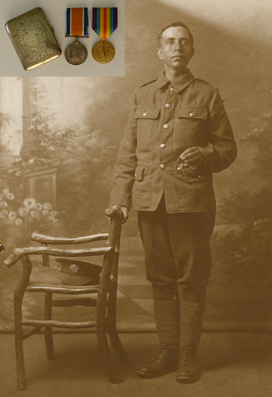Arthur Needs lived in Melton for the majority of his life. Inset: his medals and cigarette case
Arthur William Needs was the eldest son of William Everett Needs and his wife, Elizabeth Watling. His parents were married in the Woodbridge district in 1875. They started their married life together in Brigg, Lincolnshire, where Arthur was born two years later. Sometime before 1880, the family returned to Melton and were living in Tollgate Cottages on Yarmouth Road where Willian and Elizabeth went on to live for more than thirty years.
In 1881, Arthur’s eldest sister, Isabella, was born. By 1891, three further members of the family had been added; brother Walter, later to become a photographer running his own business in the Thoroughfare, Woodbridge, and sisters Maud and Alice. Ten years later, the twenty-three-year-old Arthur was still living at home and was working as a bricklayer.
On 26th June 1907, Arthur married Elizabeth Annie Foreman in Woodbridge. The newlyweds then moved to a cottage in Plantation Place, Melton, where they were living at the time of the 1911 census.
By 1914, however, when war broke out, Arthur and Elizabeth had moved into Woodbridge and were living at 12 Theatre Street. Arthur worked as a postman during this period. In August 1914, Arthur tried to enlist but was rejected on medical grounds, however, this did not deter him and finally, after the third attempt, he joined the army under the Derby Scheme on 10th November 1916. He was initially posted to the 25th Provisional Battalion, whose ranks consisted of men who were of low medical categories on home service duties. The battalion was later renamed and became the 27th Durham Light Infantry. It continued to be a home service battalion.
In the spring of 1918, the German army launched Operation Michael, an attempt to force the British Army back to the Belgium coast and out of the war. Due to the high number of casualties sustained in repelling the German offensive, men that had previously been rated as unsuitable for service overseas were drafted to France as reinforcements and Arthur was one of them, leaving his wife Elizabeth and their unborn child in Woodbridge. He was transferred to the 18th (Service) Battalion York and Lancaster Regiment and deployed to France on 3rd July 1918. On arrival in Boulogne, Arthur and his regiment marched to billets in Hardinghen, where they remained for a week undergoing training. On 11th July, the battalion received orders to move to Mouelle, a two-day march away. Once there, the battalion continued their training throughout the rest of July and most of August.
On 22nd August, the battalion marched to St Omer and entrained to Proven, near Poperinghe in Belgium, then further, to a camp at Saint-Jan-ter-Biezen. It was not long after that before Arthur and the 18th York and Lancasters were in trenches for the first time, relieving the 8th Scottish Rifles on the 28th August. Their first stint in on the front line was thankfully uneventful, with only a few enemy encounters, little exchange of fire and no casualties.
At the end of September, the battalion was moved to Messines Ridge. Throughout October they followed the German retreat until, on the 1st November 1918, they were on the front line at Espierres-Helchin on the River Escaut.
On the night of 6th November, a patrol was sent to reconnoitre the land in front of the new line just taken by the battalion. During the patrol, they came under enemy fire from a German machine gun emplacement at a sluice on the river. Arthur was severely wounded in the encounter and taken to the 43rd Field Ambulance, based at Wattrelos, some 3 miles away. On the 7th, Arthur was transferred to the 11th Casualty Clearing Station at Saint-André-lez-Lille where, on the 13th November 1918, two days after the Armistice, he died of his wounds. He is buried in the St Andre Communal Cemetery in Saint-André-lez-Lille.
Six months later, official notification of his death reached the Woodbridge Reporter and Wickham Market Gazette who reported on 29th May 1919 that: “
Arthur William Needs, who has left a wife and a baby girl to mourn his sad loss, died of wounds in France November 13th 1918. After being rejected three times he was accepted under the Derby Scheme, on November 10th 1916, and on being called up joined the East Yorkshire Regiment. Later he was transferred to the Durham Light Infantry, and afterwards to the York and Lancaster Regiment. He was sent to France in June 1918, and in November was wounded and died from his injuries. His widow and child now reside at 12 Theatre Street, Woodbridge."
For his war service, Arthur received the British War and Victory Medals. His belongings, including a cigarette case (pictured) were returned to his widow.
